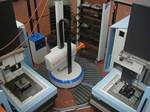10 Considerations for Choosing a Robot
Knowing what to look for is essential when comparing and evaluating robots from different manufacturers.
As you embark on the robot selection process, the following 10 items are important to consider before making your final decision.
1. Compact, efficient robot design. A compact robot design with slim arms and a small footprint makes integration easier and saves valuable shopfloor space. In addition, designs with concealed air and electrical lines keep those lines from interfering with other equipment, as well as protect them from wear and damage, which helps reduce overall costs.
2. Robot controller features. Desirable features to look for in robot controllers include compact size and light weight; fast processing speed; modular expandability to accommodate additional peripheral equipment without having to purchase a new controller; ease of integration with a vision system, PLC or other devices; and ease of servicing.
3. Affordable offline programming software. Be sure that the offline programming software being offered does not include expensive, advanced features that are unnecessary for your needs.
4. Low energy consumption. Ask about the robot’s energy consumption. Efficiently designed, slim and lightweight robot arms require less power, so their motors draw less electrical current, which can result in significant long-term cost-savings.
5. Safety codes. To protect employees and limit your company’s liability, verify that the robot meets or exceeds all current safety codes.
6. Short training. Ask about the length of required training. Unnecessarily long training can result in excessive unproductive employee time and travel costs.
7. Documented mean time between failures. Above all, robots must be reliable, and this can be verified with documentation of a robot’s mean time between failures (MTBF) provided by the manufacturer.
8. High maximum allowable moment of inertia. Look for a robot with a high maximum allowable moment of inertia, a measure of how much force it can exert. The higher the maximum allowable moment of inertia, the more easily the robot can lift and move a given payload size, putting less strain on the robot’s motors and resulting in a longer working life.
9. Continuous-duty cycle time. When comparing robot cycle times, be sure to ask whether the figures given are for continuous duty, or only shorter bursts of an hour or less. If the latter, the robot will have to operate at a slower speed in normal operation.
10. Experience and reputation of the robot manufacturer. Look for a manufacturer that has established itself as an industry leader and whose robots have stood the test of time. Also look for a manufacturer who understands the importance of product training by offering basic and advanced comprehensive operator, programming and maintenance training for its robots through a variety of classroom sessions, computer-workstation interaction and hands-on robot training.
Related Content
-
Mold Design Review: The Complete Checklist
Gerardo (Jerry) Miranda III, former global tooling manager for Oakley sunglasses, reshares his complete mold design checklist, an essential part of the product time and cost-to-market process.
-
What You Should Consider When Purchasing Modified P20 Steel
When buying P20 steels that have been modified, moldmakers must be aware of the variations and key issues that affect delivery, cost and lead times.
-
Laser Welding Versus Micro Welding
The latest battle in finely detailed restoration/repair of mold materials.











